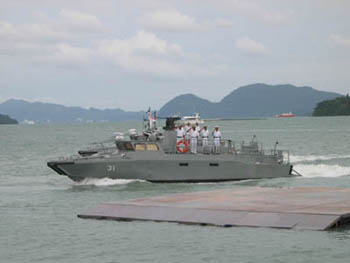
Since the first four units of CB90h combat boats were bought by the RMN in 1999, it was generally assumed that the boats were only armed with heavy machine guns of .50 calibre mounted at weapon ring at the most. Although around 2001 the navy had tested the installation of Giat Indus

tries 15 A Ultralight 20mm manual mount guns in Sabah waters, involving the firing of 1,200 shots at 600 to 1500 metres, nothing came out of this and the weapon was not installed on the combat boats. Thus even though these CB90s play an important role in the LIMA stations and in OPS PASIR, compared to other patrol boats the nation has these boats are relatively undergunned for their tasks as they have to depend on manually operated GPMGs while conducting their operations.
Nonetheless while trawling the internet, I came across a photo of

two docked CB90s that I believe is in Sabah with their weapon system covered up. This piqued my interest and after further research, I found that the weapon system is the Bofors/BAE System Lemur remote controlled mach

ine gun. This system actually debuted in LIMA 2005 and was demonstrated to the public, but I guess nobody picked up that the RMN had actually bought a few systems for their CB90s, possibly because these were based in Sabah waters as none of the CB90s based in the peninsular has been shown with the system installed. Personally I think that it was a

good move by the RMN to installed such remote controlled system for the combat boats instead of manual guns since the boats can move at very high speed and I cannot imagine how someone can manually man a gun with all the pitching and yawing. Now if somebody can just tell me what calibre machine gun is used with the Lemur mount as it can be installed with a 7.65mm or 12.7mm machine gun or even an automated grenade launcher. Either way the combat boats are now better armed for their operations, so let's hope all of them will be similarly armed finally.







 So if shortage of funds is a hindrance especially if this is due to a possible upgrading of its armaments, then lets proceed with the plain vanilla configuration as per the first batch as long as the vessels are builts. That is why it was designed as a fitted for not with platform, so that once funds becomes availables it can be up-gunned as required no matter how this concept has been pilloried by those ignorant of its value. We need the platforms for offshore patrol of our national waters, there is no need to second-guess that. What should be left now is a debate on how to name the new class, and can I venture it to be the Sabah class for both national unity and nostalgic sake.
So if shortage of funds is a hindrance especially if this is due to a possible upgrading of its armaments, then lets proceed with the plain vanilla configuration as per the first batch as long as the vessels are builts. That is why it was designed as a fitted for not with platform, so that once funds becomes availables it can be up-gunned as required no matter how this concept has been pilloried by those ignorant of its value. We need the platforms for offshore patrol of our national waters, there is no need to second-guess that. What should be left now is a debate on how to name the new class, and can I venture it to be the Sabah class for both national unity and nostalgic sake.









